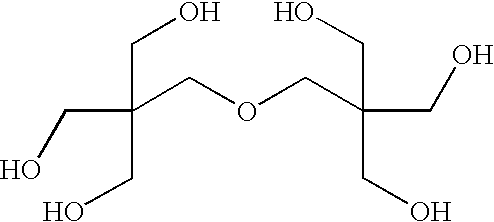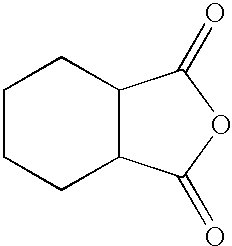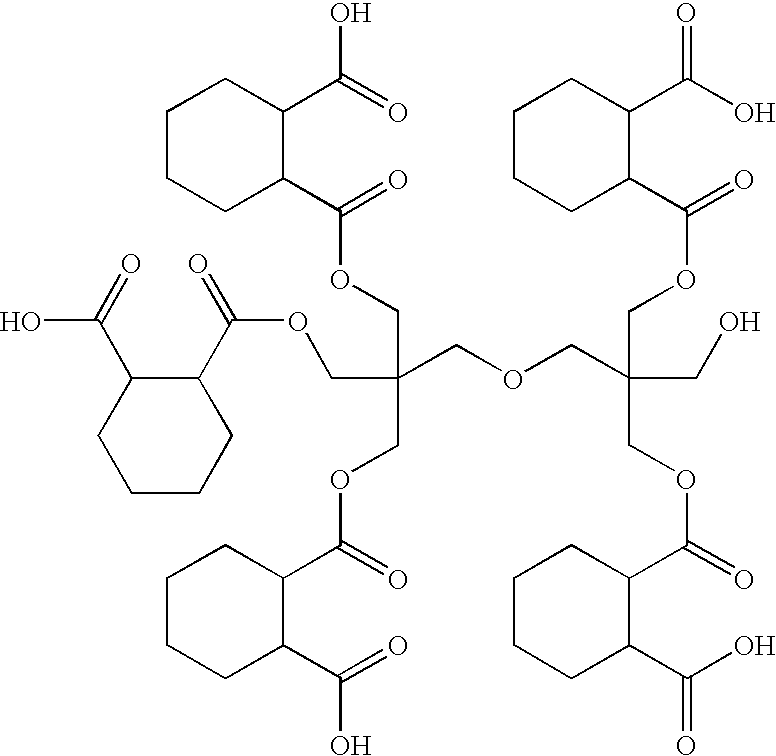Polymeric pigment dispersant utilized as a grind resin for pigments and method of preparing the same
a polymer pigment and dispersant technology, applied in the field of pigment dispersant, can solve the problems of ineffective inadequate inability to use pigment dispersants of the prior art, so as to improve the stability of pigment dispersants, and improve the effect of pigment dispersants
- Summary
- Abstract
- Description
- Claims
- Application Information
AI Technical Summary
Benefits of technology
Problems solved by technology
Method used
Image
Examples
examples
The polymeric pigment dispersant was prepared by adding and reacting the following parts, by weight, unless otherwise indicated.
TABLE 1AmountAmountReactant(moles)(grams)Dipentaerythritol1126.91[DPE]Hexahydrophthalic3230.25anhydride[HHPA]Glycidylneodecanoate1118.44[CARDURA E 10S]Dimethylethanolamine—96.60 DMEA + 379.53[DMEA] Solution #1De-ionized WaterPolyphosphoric Acid— 10.86Dimethylethanolamine—15.89 DMEA + 21.52[DMEA] Solution #2De-ionized Water
Per the above table, Table 1, 230.25 grams of HHPA were added to 126.91 grams of DPE. The mixture was heated via a conventional heat supply to a temperature of 120° C. to 125° C., when an exotherm was observed, peaking at approximately 150° to 165° C. After this exotherm, the batch was allowed to cool and was maintained at 130° C. for approximately two hours. Standard titration for acid number revealed that the reaction to form the intermediate compound was complete. Next, 118.44 grams of CARDURA E 10S were added to the intermediate comp...
example 5
rporated into Examples 5A-5C shown in Table 5. Examples 5A-5C each have a different binder resin making up the coating composition. Table 5 details the coating composition components and the respective percentages.
TABLE 5ExampleExampleExampleCoating Composition Component5A5B5CPigment Dispersion (Table 4)29.9%29.9%26.1%Polyester-Polyurethane Resin37.5%13.8%0.0%Acrylic Resin0.0%23.7%0.0%Acrylic Emulsion0.0%0.0%33.5%Melamine7.5%7.5%6.1%De-ionized Water6.3%6.3%15.7%Co-Solvent9.6%9.6%6.5%Rheology Control Agents6.8%6.8%1.2%Aluminum Pigment Slurry1.5%1.5%1.2%UV Screener0.7%0.7%0.3%pH Control Agent0.2%0.2%1.3%Filler0.0%0.0%3.7%Free Resin0.0%0.0%3.5%Catalyst0.0%0.0%0.9%
The coating compositions of Table 5 were applied to a substrate and tested. The coating compositions in Table 5 were utilized as a basecoat and were applied to the substrate. The basecoat was then flashed at 130° F. Next, a clearcoat, commercially available from BASF Corporation, Southfield, Mich., as Duraclear, was applied to...
PUM
| Property | Measurement | Unit |
|---|---|---|
| temperature | aaaaa | aaaaa |
| temperature | aaaaa | aaaaa |
| temperatures | aaaaa | aaaaa |
Abstract
Description
Claims
Application Information
 Login to View More
Login to View More - R&D
- Intellectual Property
- Life Sciences
- Materials
- Tech Scout
- Unparalleled Data Quality
- Higher Quality Content
- 60% Fewer Hallucinations
Browse by: Latest US Patents, China's latest patents, Technical Efficacy Thesaurus, Application Domain, Technology Topic, Popular Technical Reports.
© 2025 PatSnap. All rights reserved.Legal|Privacy policy|Modern Slavery Act Transparency Statement|Sitemap|About US| Contact US: help@patsnap.com



